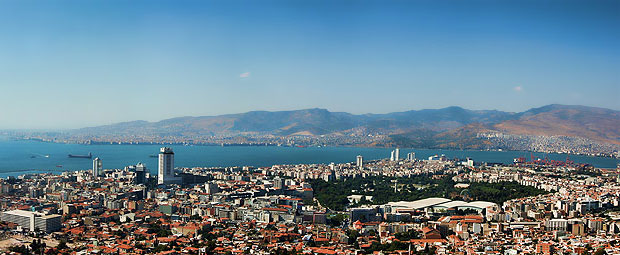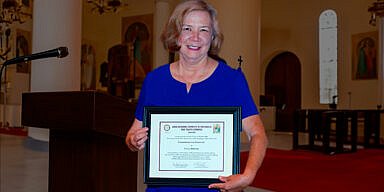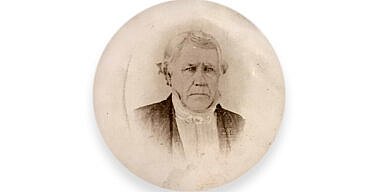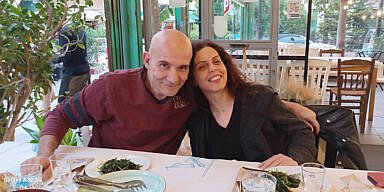There is something about travel to our lost homelands that creates spectral yearnings in me. I have had the great fortune to visit and to experience nearly every country bordering Greece, or where the Byzantine legacy still remains in culture or edifice. Nowhere were the ghosts more numerous than in my visit to Smyrna last autumn.
This is probably because Byzantine and Hellenic legacy is officially expunged from the record in Izmir, whereas in Constantinople there is still a tiny Greek community and the Patriarchate of Constantinople maintains a slipping grip on the spiritual legacy of Byzantium, and over all Orthodox. It could be, too, that what “The City” represents simply transcends the grave for Byzantine descendents. Whatever it was, even Constantinople did not stir up the same whirl of spectral emotions as Smyrna.
No family ghosts are there for me. My lineal family is all from the Western side of the Aegean, unlike so many of my fellow Greek tourists on this particular trip. We arrived after a brief flight from Athens, and proceeded into the city of Izmir, whose upper town, crescent shaped harbor, and seaside highway immediately brought Salonika to mind. It was not just topography talking—many of today’s Izimiris were Salonikans, and today’s Salonikans were Smyrnans, the human legacy of the exchange. On the highway to Izmir, we rounded a bend where a huge rock carving bore the likeness of another Salonikan, Kemal Attaturk, the founder of the Turkish Republic.
Izmir greeted us cloaked in Turkish flags, as we arrived on Republic Day. Never had I seen so many flags, not even in post-9/11 America were so many flying, and at sizes ranging from toddlers with paper jobs, to six story buildings totally draped. Shakespeare’s phrase about “protest[ing] too much” came to mind. In Izmir itself, a Greek seeking many ready reminders of Greek Smyrna will be frankly disappointed. The Greek Quarter was consumed by fire and ploughed under for parkland.
Some structures do remain, including a couple of formerly Greek high schools in a high neoclassical style now appropriated by Turkish universities, and some stately homes with gabled second stories known in the Balkans as Turkish houses and in Turkey as Rum (Greek)-style houses. In today’s Izmir the greatest enemy to remaining Greek architecture is not the erasing efforts of Turkish nationalism, but a far greater enemy and one well known to Athenians, “progress.” Builders arrive with cash and promises of apartments, and mansions of a bygone era come down.
Then there are the Smyrnans of today, the Turkish Izmiris. Absent the veiled women, relatively few in number in this city, one easily sees the faces of Athens, Salonika, Sofia, Skopje or Belgrade. Or Iraklion. At a café in Smyrna’s upper town, where Turkish couples sipped beer in fashion and form no different from their Balkan neighbors, a fellow, hearing us speak Greek, opened a conversation.
He spoke an unsteady Greek filled with Cretan idioms, astonishingly similar to the Cretan dialect I heard from Old Timers from the Greek community in my Salt Lake City, Utah hometown. Switching to his more fluent English, he informed me that his grandparents were Cretan Muslims, that there were hundreds of thousands of Cretan descendants in Turkey, and that “Greeks and Turks are brethren.” We met others, in the course of our trip, including an elderly café proprietress who shared a Cretan mantinada with a fellow tour member, a professor born in Crete. Few eyes were dry.
Walking along Izmir’s waterfront, full of swanky apartments every bit the kin and peer of Waterfront Salonika or Glyfada, I expected to feel ghosts, for before arriving I had reread several accounts of the last days of Greek Smyrna, and horrors endured by hundreds of thousands of Asia Minor Greeks and Armenians, caught between fire and sword on the land, and the sick indifference of Allied ships in the harbor. A quick stroll down the strand was enough. The blackness of the sea and the lights of the city easily remind of the countless thousands who met a watery grave. As I was with my new Turkish friends at that particular moment, whose kindness and hospitality easily compares to the best of the Greeks, the ghosts beat a diplomatic retreat, and the memories washed down with Turkish beer.
The nearby ruins of Classical Ephesus conjure images of Greek civilization, and the very font of Christianity, clearly antecedents confirming Asia Minor’s Greek Christian past and the Turks as latecomers and awkward inheritors of its present and future. Here, again, were ghosts of the past, but of an earlier era, lacking the nearness and intimacy of those more closely associated with our era.
It was, rather, the villages near Smyrna, less impacted by modernity, more readily and visually connected to our Greek present, where the ghosts came out in force. There was the village of Urla (Vourla) now nearly a suburb of Izmir, with global chic from the city annexing the charms of a once Greek fishing village. Greece’s Nobel Laureate poet, George Seferis, was born here, and the Turks celebrate this native son with a street named for him, and restaurant adorned with Greek and Turkish flags.
Breaking away from the tour, as I often do, I walked the quiet streets of the town, not much changed since the Greeks left these same houses in haste. Then I walked to the small port, in every way the same as a thousand such seaside towns in Greece, and a Turkish sailor sat in the late autumn sun, burned the same crimson as his counterparts in my home island, Hydra, cleaning his nets with the help of a big toe for leverage.
North of Smyrna, the town of Foca beckoned. Known until recently as Phocea, its citizens founded the city of Marsailles in France almost three thousand years ago. The Greek presence here ended abruptly in 1922. One of my fellow tourists recalled that his grandfather owned several factories here, sighing the sigh of fate and futility I have so often witnessed on both sides of the Aegean or anywhere in the Balkans, when recalling such things.
We arrived to a port every inch Greek, settling in a fine restaurant eating barbounia at a price and freshness hard to come by. Out at sea we could just make out a hazy silhouette of Lesbos, and over the Karaburun peninsula opposite Chios would have been visible, all linked together in a web of commerce and culture, until the tragic events of the 1920s. Well sated and on unsteady legs from too much raki and nostalgia, we then took to the back streets of Foca, where the ghosts readily walked the narrow alleys, whose houses had not changed since the 1920s and door lintels often had faded inscriptions in Greek. The exchange might have happened yesterday, from the town’s aura, and so it was just a blink in the eye, relative to the millennia-long history of Hellenism here.
Though Greek Christianity was officially expunged from Asia Minor, its aural presence remain, and physical traces abound, hidden in plain sight. The DNA and features of the people told a similar story, as did the all too often facility with the Greek language due to pre-exchange ties which still held. This part of Turkey is a must see, not only for what is seen, but more importantly what is not seen, but rather felt.




